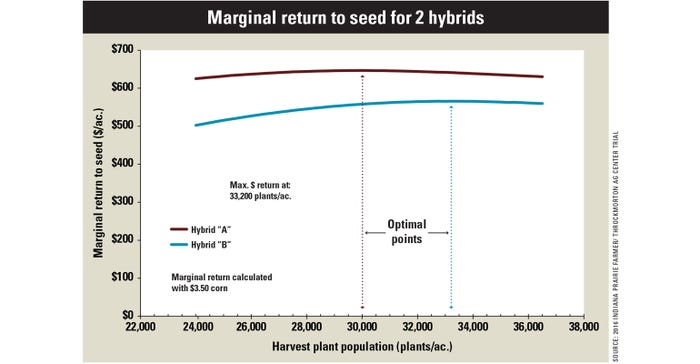
What is the optimum agronomic plant population for producing the highest corn yield? Does it vary by hybrid? What is the optimum economic population at which you make the most money per dollar invested? Is it different than the optimum agronomic population for that hybrid?
These were questions that an exclusive 2016 Indiana Prairie Farmer/Purdue University and Throckmorton Ag Center research trial attempted to answer. Two hybrids were tested at five seeding rates, ranging from 26,000 to 39,000 seeds per acre. The hybrids were provided by Beck’s, Atlanta, Ind.
This trial wouldn’t have been possible without the help of key individuals. Pete Illingsworth, an experienced crew member at Throckmorton, planted and harvested the trial plots. Karen Mitchell, the Tippecanoe County Extension ag educator, recorded weights and yields for each plot. Bob Nielsen, Purdue corn specialist, analyzed the results and prepared the graphs using regression analysis. Daniel Bechman, a product specialist for Beck’s, assisted in taking stand counts before harvest.
Here are 13 key findings from this trial:
1. The results represent what happened at one location in one year. Trials conducted at multiple locations over multiple years are the most meaningful. However, a single-year trial in one location can point to possible trends and raise unanswered questions.
2. The graph “Yield response of 2 hybrids” (below) indicates there was a difference in yield response. The two hybrids yielded at different levels when all populations were averaged together. Hybrid A yielded over 20 bushels per acre more than Hybrid B.
3. Population for highest yield varied by hybrid. The yields shown on the yield graph are estimates based on regression lines. The highest yield, or optimum agronomic population, for Hybrid A was 32,800 plants per acre. The optimum agronomic population for Hybrid B was 35,400 plants per acre.
4. Optimum economic populations are lower than optimum agronomic populations. Nielsen used a $3.50-per-bushel corn price and $250-per-unit seed cost when calculating returns. Maximum return for Hybrid A came at 30,000 plants per acre. Optimum economic population for Hybrid B was 33,200 plants per acre.
5. These results are based upon actual populations, not seeding rates. Actual population is what matters, Nielsen emphasizes. Once you know the population, work backward to determine seeding rate.
6. Optimum economic seeding rates were determined assuming 95% emergence and final stand. The optimum economic seeding rate for Hybrid A was nearly 32,000 seeds per acre. For Hybrid B, it was over 35,200 seeds per acre.
7. Optimum agronomic and economic yields are in line with other Purdue trials in Indiana. Check out the results for other trials at kingcorn.org/news/timeless/CornPopulations.pdf. The sweet spot for optimum payback appears to be at populations between 28,000 and 35,000 plants per acre on average or better soils, Nielsen says. This range is based on 67 on-farm trials and other trials since 2008.
8. Optimum population ranges would be different for marginal, droughty soils. On soils prone to drought, the optimum agronomic and economic population ranges are less than 25,000 plants per acre, Nielsen says.
9. The seeding rate needed to achieve optimum population depends upon your situation. Normally, Nielsen finds populations end up within 95% or higher of seeding rates. In this study, the population averaged 94% of seeding rate.
10. Examine causes of reduced stands more closely in the future. Population was just over 91% of seeding rate in a few treatments. Since an as-applied planting map wasn’t available and early-season stand counts weren’t taken, it’s impossible to determine if above-average stand loss was due to planter issues or other causes.
11. The highest-yielding hybrid peaked at a lower population than the lower-yielding hybrid. If that stumps you, it’s because you likely brought bias into examining the results, Nielsen says. What counts is what happened, not what you thought should happen.
12. High yield and response to population are not well-correlated. Nielsen says in his field trials over time, he has found little correlation between which hybrids yield most and what population a hybrid performs best at — sometimes the highest-yielding hybrid performs best at lower populations, like here, but sometimes not.
13. What the seed company says about these two hybrids makes sense. As it turns out, Beck’s, the company that provided the seed, recommends planting Hybrid B at somewhat higher seeding rates, and Hybrid A at relatively lower seeding rates. This particular trial backs up that recommendation.


About the Author(s)
You May Also Like




